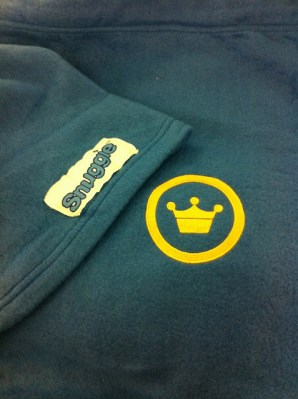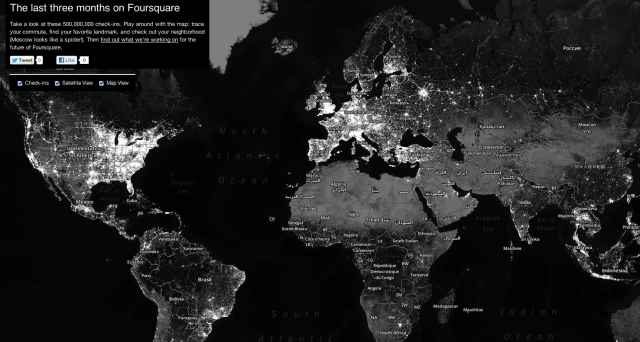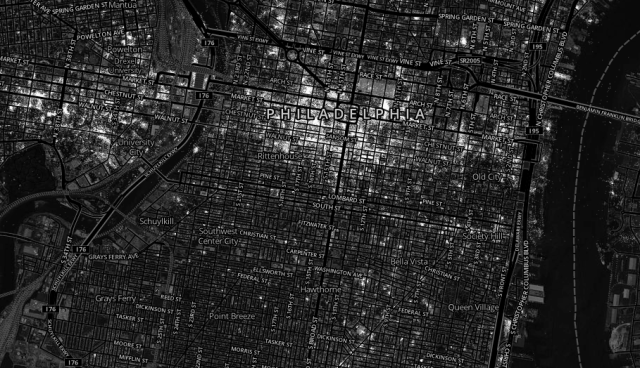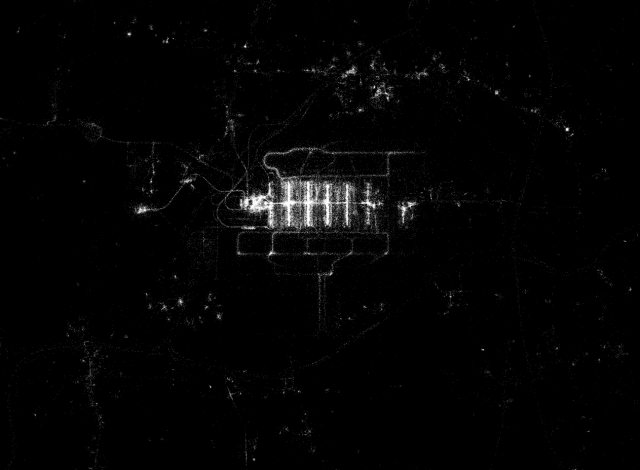Any mature Internet product always has difficulty proving its success or illustrating its evolution. Foursquare is definitely one of the companies with a product that fit into many buckets, depending on who you talk to. Today, the company has released a detailed, interactive and gorgeous, topographical map, plotting out 500 million check-ins from the past three months.
There are quite a few things you can glean from this, perhaps the most interesting being that Foursquare isn’t a product that’s simply popular in San Francisco or New York City. Since launching at SXSW in 2009 in 10 major cities, the app has grown to 35 million registered members who are visiting places all over the globe.
The company has raised $71.4 million to date, from every big player in venture capital, but some pundits and users aren’t sure where Foursquare is headed in the near or long-term. Foursquare’s strength, as most big platforms can attest to, is the data that it collects from its engaged users. As we noted last October, the company is moving towards becoming a destination, and utility, for discovering places around you in the real world. And from your mobile device primarily, to boot. This is not an easy problem.
The map allows you to zoom in on different areas of interest, going down to a street level:
I spoke with Foursquare’s data scientist, Blake Shaw, about what all of this data means and what Foursquare’s goals are for 2013:
We’re starting to realize that people want tools to find the best places, no matter where they are, a familiar city or not. We’re building more tools to achieve just that. We’re also starting to fully leverage our data and aggregate signals to make a more quality signal and experience for users. We’re looking at things like: How often do people come back to a place? What type of people like to come to a place?
It all comes back to data, and Foursquare has quite a bit of it. I asked Shaw how Foursquare users have evolved, as far as what types of features they’re asking for and expect:
As we’ve grown, users expect a lot more, people really want mobile tools that really fit into their lives. People aren’t sitting at their desk trying to access information, they’re on their mobile device in the real world.
In the situation that Shaw explains, Foursquare is trying to become a utility for mobile users. This is a pretty big goal, but it makes sense now that Foursquare has a mature set of data to pull from. Think about it: When you’re on the move, do you want to tap a bunch of buttons, choose filters and get asked a series of questions? No, you just want suggestions for places you can try out, based on where you’ve been before. That’s what Foursquare has become.
The tool that Foursquare launched today could turn into an actual product, Shaw told me. Based on trends, you could see on a map which spots are hot on, say, Sunday. If you’re looking for a bar that has a lot of people, you’d want to gravitate to an area that’s “lit up.” If you’re someone who likes things to be low-key, you can do the opposite.
If you take a look at this map of Philadelphia, you can see that all of the historic landmarks get checked into quite a bit:
It gets pretty busy in those areas, especially on the weekends and holidays. I only know that because I used to live there. But with where Foursquare is going, everyone can have that intelligence, even if they’ve only been there for a few minutes.
Shaw went into more detail when it came to the future of Foursquare, and how far it’s come since 2009:
———–
TechCrunch: What has surprised you the most over the years as users have started evolving with Foursquare?
Shaw: Foursquare started out as a way for people to share the bar they were at with nearby friends, and it’s turned into something much bigger. People are now using their phones out in the real world to connect to immense amounts of local knowledge, to discover new places, or to get recommendations from their friends. While these maps are a beautiful visualization of check-ins from cities around the world, they also represent a huge dataset we can use to better understand places and build new tools for navigating the real world.
TC: When you look at this map, what jumps out at you as the most interesting thing?
Shaw: The high level of detail in these maps is very interesting. This is a new perspective on what cities look like in terms of the underlying social behavior of their citizens. Plotting check-ins allows us to perfectly see roads, runways, and ferry lines, while also quickly pointing out the most popular areas of a city.
We are measuring this incredible signal — what people are doing in the real world at every moment. With each check-in Foursquare gets a little bit smarter, we learn a little bit more about where places are, when they are busy, and who likes to go there. We are providing contextual relevance around the data we collect – something no one else can do. And that data goes into building a personalized recommendation engine for people looking to discover new places. It’s like when the web went from directories to search – relevance was added to make recommendations matter more.
TC: What jumps out as the biggest validation of what Foursquare is about and is doing?
Shaw: We started Foursquare with this somewhat quirky tagline – make the world easier to use. But the underlying message there is technology can make your real-world experience – when you’re not in front of your computer – so much better.
More than 30 million people have checked in more than 3 billion times and left tens of millions of tips at nearly 50 million points of interest across the globe. They turn to us every day for ideas on what to do and how to best spend their time. This massive amount of data enables Foursquare to do things others can’t, like provide contextually relevant answers for people looking to discover new things to do around them.
On the business front, we launched a pilot program over the summer aimed at helping business owners more actively engage the Foursquare users who are also their customers. More than 1 million businesses have claimed their venue, allowing them to get a better sense of who is coming in their doors, and how they can better engage their customers. We are also working with six of the 10 biggest merchants in the country, including Best Buy, Gap, Walgreens, and Starbucks to provide special offers or promoted placements in our app.
TC: How big is the team right now and what are its goals for 2013?
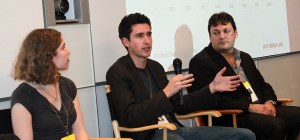 Shaw: Foursquare has roughly 150 employees across offices in New York, San Francisco and London. We are continuing to build out the engineering team that is helping to create our new features and products, as well as staffing up our new sales team led by our chief revenue officer.
Shaw: Foursquare has roughly 150 employees across offices in New York, San Francisco and London. We are continuing to build out the engineering team that is helping to create our new features and products, as well as staffing up our new sales team led by our chief revenue officer.
TC: Most people think of Foursquare as just a check-in app. What is the company doing to change that?
Shaw: Foursquare is going through a natural evolution. Check-ins were the first way most people interacted with us. It took billions of those check-ins before we could build and launch Foursquare Explore – and people are now using it to meet up with friends and discover new places.
What we’re seeing is similar to what Twitter experienced around 2008. Initially, they were a place people went to share something. Over time, they evolved into a venue for people to consume information. We’re going through something similar. A few years ago, we were the place for you to share where you were. But now, we’re the place millions of people go to for ideas on what to do next – be it a particular item to order off a restaurant menu, or a fun place to go, or a new bar to try in your neighborhood. We see that evolution – towards being an app that people use to discover new places – continuing in 2013.
TC: What excites you most about working at Foursquare right now?
We’re building something that makes people’s experiences better in the real world. People carry these amazing devices in their pockets, connecting them with others and the world around them.
What excites us the most is using all of this data being generated by these devices in new ways. For example, Explore is now more aware of a person’s context when they are using the app. When a person is traveling in unfamiliar areas, we detect this important bit of context and use it to make our recommendations more relevant. We can surface places other travelers like you went to when they were in that same location. We are entering a new age of cartography, where maps will change to better suit who is using them, and will be created collaboratively by you, your friends, and millions of other people.
———
Whether you use Foursquare to check-in or not, you can still find value from all of the data that it has collected over the years. The company hopes that by using this data, you’ll be inclined to participate as well. Think of this as the great re-onboarding of Foursquare. It’s not just for geeks, and it’s not just used in major cities like San Francisco and New York.
In the same way that you don’t really have to tweet to get the most out of Twitter, Foursquare has tools for everyone on the go, even if they don’t want to share how often they hit up Starbucks for coffee. That is the purest definition of a powerful utility.
It’s global and it’s growing.
